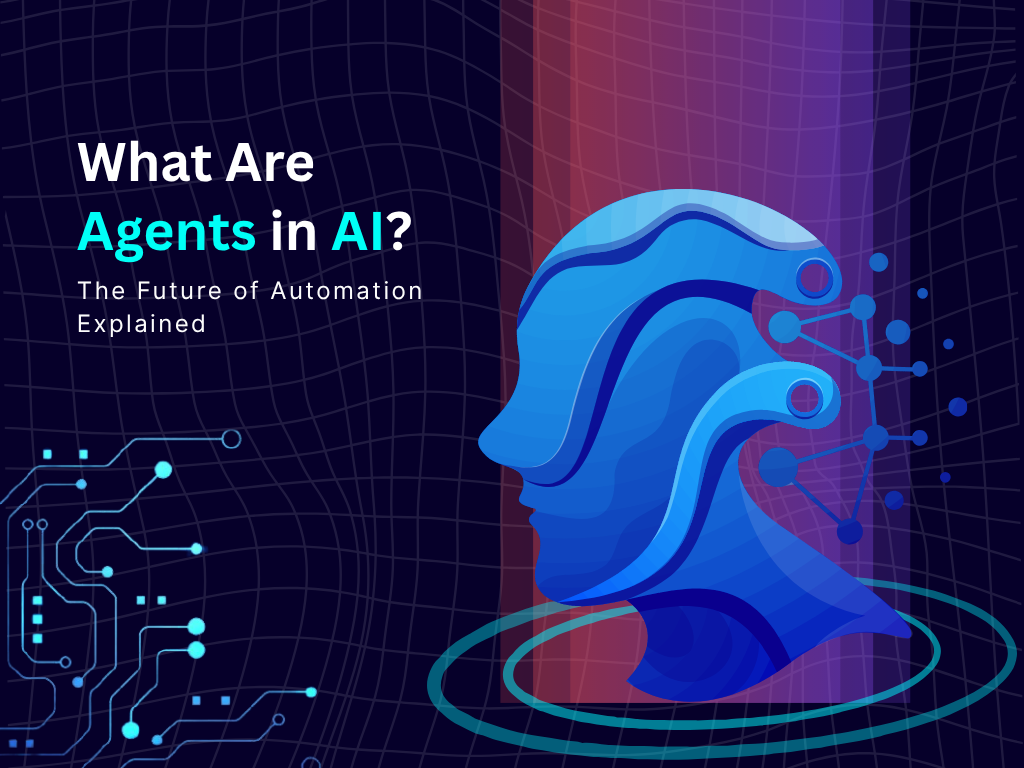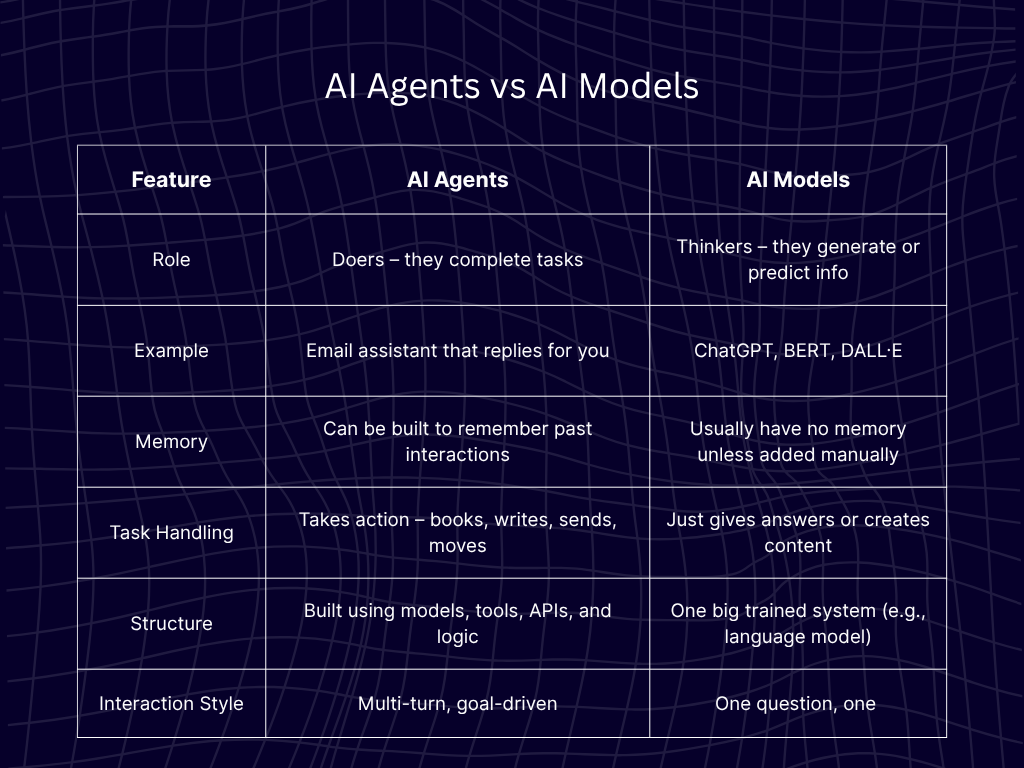
What Are Agents in AI? The Future of Automation Explained (In Simple Words)

Imagine waking up and your emails are sorted, your meetings scheduled, your documents drafted, and your reports analyzed. It’s AI agents stepping in, not to take over, but to take away the parts of your day that drain your time.
Most people still think artificial intelligence is about robots or chatbots that give generic replies. Traditional AI systems are often limited to handling specific tasks, while modern AI agents can manage a broader range of activities and adapt to new challenges.
But there’s something that’s starting to reshape how people work, learn, and live without anyone noticing it fully. These aren’t just tools or software. They’re like tireless co-workers, always on standby, learning quietly in the background, waiting for instructions that once took entire departments to handle.
An AI agent's ability to learn, adapt, and improve its performance over time through feedback and ongoing evaluation sets it apart from earlier systems.
Custom AI agents for business are already writing code, talking to customers, booking flights, managing schedules, and even planning product launches. And the real twist?
Many businesses and individuals using them don’t even realise they’re handing over such control to systems that can think, respond, and act. Here’s what are agents in AI and how they work.
Let’s talk about how AI is changing the way we solve problems.
Artificial Intelligence, or AI, is changing the way we solve problems and get things done.
Instead of relying only on humans to handle complex tasks, AI allows machines to perform tasks that once required human intelligence—like understanding language, recognizing patterns, or making decisions.
At the heart of this revolution are AI agents: intelligent agents that can sense their surroundings, make choices, and act to achieve specific goals.
These AI agents aren’t just simple programs. Thanks to advances in machine learning and natural language processing, they can learn from experience, adapt to new situations, and operate in dynamic environments where things are always changing.
Sometimes, a single AI agent is enough to perform tasks based on its own observations. Other times, multiple AI agents work together in a multi agent system, collaborating to tackle complex tasks that would be too much for one agent alone.
This teamwork allows AI to solve bigger problems, faster and more efficiently than ever before. But then, What Are Agents in AI?
What Are Agents in AI?
You give an AI agent a job, and they go do it. Not just once. Not just as a one-off click. These agents remember, adapt to patterns, and carry out instructions.
In simple terms, an AI agent is a program that can think about a problem, decide what to do, and take action without someone constantly watching over it. Unlike basic software that waits for you to click a button, these agents can move through tasks on their own.
Let’s imagine a library assistant who already knows which book you want, finds it, checks it out for you, and emails the author if it’s missing. That’s how AI agent implementation works while writing emails, doing marketing, design, research, sales, and just about any area that involves routine work or repeating patterns.
How Do AI Agents Work?
Custom AI agents for business operate a bit like humans. They sense, decide, and act.
Here’s the three-part cycle that runs inside every AI agent:
1. Perception
This is where the agent pays attention. Just like a person listens, reads, or watches something before responding, an AI agent “perceives” its environment. It could read your message, scan a database, or check the weather.
But this isn’t just passively reading. It’s interpreting the input. If you send a command like “send a follow-up email to leads who didn’t reply in 3 days,” the agent looks for clues:
- Who are the leads?
- Who hasn’t replied?
- What counts as 3 days?
- What kind of message should it send?
An AI agent might misread intent if the data is messy, unclear, or incomplete. That’s why good results depend on giving it the right kind of clues.
2. Decision
Based on what it saw, the agent now picks a direction. Should it send that email? Wait another day? Escalate to a human? Rewrite the draft? The decision isn't just a yes or no. It could be a whole plan.
Some custom AI agents for business comes with reasoning layers. These let them weigh options, backtrack if needed, and even argue with themselves internally. This doesn’t mean they “think” like humans, but they can explore multiple routes before choosing one.
And not all AI agents use deep learning or neural networks. Some work on old-school logic systems, others on newer methods like reinforcement learning. The tech behind them varies widely, even though they all follow the same loop.
3. Action
After deciding what to do, the agent takes action. It might write, click, send, move, book, call, schedule, or reply. All of it is done through software connections, scripts, or APIs.
Some actions include sending an email or posting a tweet. Others are researching a company, creating a presentation, sending reminders, and managing replies. And once the action is taken, the agent circles back to perception.
Did the email bounce? Did the recipient reply? Was the action successful? If not, it tries again or chooses a new path.
Here’s a real-world example of how AI agents work in a sales task:
- Perception: It checks which leads have not replied in 5 days.
- Decision: It decides which leads are worth nudging again.
- Action: It writes and sends a personalised email, waits 48 hours, checks for replies, and sends another follow-up if needed.
All without someone hovering over it.
Types of AI Agents
There are several distinct agent types in enterprise AI automation, each with different roles, capabilities, and ways of making decisions. Think of them as digital workers with specialized functions, collaborating or operating independently within the same company.
Simple reflex agents are the most basic agent type. They operate solely based on current perceptions and follow predefined rules to determine their actions, making them simple but limited in scope.
Model based reflex agents, unlike simple reflex agents, use an internal model of the environment to interpret perceptions and make more informed decisions. This allows them to consider past and future states, filling in missing information for better adaptability.
Model based agents form a broader category that includes any agents using internal models for reasoning, planning, and enhanced decision-making.
Goal based agents make decisions by evaluating actions according to specific objectives, allowing them to operate autonomously in complex environments.
Utility based agents use a utility function to compare possible actions and select the one that maximizes expected utility, which is especially useful in scenarios like autonomous vehicles determining optimal routes.
There are also other agents that may interact or collaborate with other agents, working together to solve complex problems within larger systems.
Applications of AI Agents
AI agents are making a real difference across a wide range of industries by taking on routine tasks and supporting human agents in new ways. In customer service, for example, AI agents can answer common questions, route more complicated issues to human agents, and even offer personalized recommendations—all without a break. This frees up human agents to focus on more complex or sensitive customer needs.
In healthcare, AI agents analyze vast amounts of medical data, identify patterns that might be missed by the human eye, and help doctors make better decisions about diagnosis and treatment.
Healthcare AI agents can also automate routine tasks like scheduling appointments or sending reminders, improving efficiency and patient care.
Finance is another area where AI agents shine. They can monitor transactions to detect fraud, predict market trends, and provide tailored investment advice.
In supply chain management, AI agents help companies optimize logistics, predict demand, and automate routine tasks, leading to significant cost savings and smoother operations.
By automating repetitive work and supporting human agents, AI agents not only boost productivity but also enhance customer experiences and drive innovation across industries.
How to Create an AI Agent
Now that we know what are agents in AI, let’s understand how to create them. The process might sound technical, but it can be broken down into simple layers.
1. Define the Job
Start with a clear task. What will the agent do? Will it book meetings, track emails, or answer support tickets?
Agents work best when their task is narrow and well-described. Vague ideas confuse them. Think: “Write thank-you emails after interviews” rather than “handle my inbox.”
2. Choose the Tools
To build an AI agent, one needs a mix of:
- A language model (like GPT) to understand and generate responses
- APIs to access apps (email, calendar, CRM)
- A task manager (like LangChain or AutoGen) to keep track of what the agent is doing.
3. Train or Connect the Brain
If the custom AI agent development has an existing model, there’s no need to “train” it from scratch. Just connect it with clear instructions. For more advanced agents, some coding or fine-tuning might help them understand the task better.
Tip: Keep prompts short and specific. Agents don’t like long-winded instructions.
4. Give Memory (Optional)
Want the agent to remember past tasks or user preferences? Set up storage like a vector database (e.g., Pinecone or FAISS). This lets the agent refer back to past chats or tasks.
This is like giving your assistant a notebook to jot things down.
5. Test and Repeat
Run small tests. Watch how the agent behaves. If it messes up, tweak the prompts or logic. Like any new hire, it might need some hand-holding in the beginning.
AI Agents vs AI Models
It’s easy to mix them up, but AI agents for enterprise and AI models aren’t the same thing. Here’s a table to clear that up:

Real-Life Examples of AI Agents
To understand how custom AI agents for business are already shaping day-to-day life, here are a few examples most people interact with.
1. Chatbots
These are often the first line of contact on websites. They reply to basic queries, direct people to the right department, and even handle simple tasks like booking appointments or tracking orders.
What makes them agents? They don’t just answer questions. Some can take action, such as initiating returns, rescheduling bookings, or escalating issues based on what someone says. Chatbots can work nonstop, make zero typos, and never need coffee breaks.
2. Self-Driving Cars
Autonomous vehicles might feel futuristic, but custom AI agent development sits at the wheel of this concept. These agents constantly gather data from sensors about speed, traffic, road signs, pedestrians. They make quick decisions about steering, braking, or changing lanes.
What’s interesting: These cars rely on multiple agents working together. One monitors surroundings, another interprets what’s happening, and another acts on it instantly.
3. Automated Trading Bots
In financial markets, time is money. Traders are now using AI agents to monitor stock trends, execute trades, and manage risks without human intervention.
Why it matters: These bots don’t just crunch numbers. They learn patterns over time and can react faster than any human during a price shift.
4. Virtual Assistants
Think Alexa, Siri, or Google Assistant. These helpers play music, set alarms, send texts, and even control smart homes.
What makes them agents: They use voice inputs, understand context, make decisions (like choosing which lights to turn on), and act while learning how someone speaks or what they typically ask.
Why AI Agents Matter
The benefits of enterprise AI agent development are now reaching different layers of society like businesses, governments, and even personal lives. Here's how:
1. For Business: Saving Time and Resources
AI agents can take over repetitive work. Tasks like answering emails, sorting files, scheduling calls, or handling customer complaints no longer need to be done manually.
This frees people up to work on things that require thought, experience, or conversation. Companies that adopt agents can move faster without adding extra heads to the team.
2. For Society: Smarter Services
From traffic lights adjusting in real time to medical systems analysing scans, AI agents are powering services that used to rely entirely on humans. The result? Faster diagnosis, better safety, and improved public service delivery.
For instance, some cities use AI to detect unusual water usage and prevent leaks.
3. For Individuals: A More Organized Day
Anyone using a virtual assistant, personal finance app, or email organizer is already getting help from AI agents. These tools remember what someone does often and start doing it for them.
Example: An email agent can read messages, tag them by topic, and summarise what's important. AI agents help people feel less scattered by offloading mental clutter.
Challenges of AI Agents
While AI agents offer incredible potential, their development and deployment come with a unique set of challenges. One of the biggest hurdles is ensuring transparency and accountability in the decision making processes of AI agents.
Because these agents operate autonomously, it can be difficult to understand how they arrive at certain decisions, especially when they rely on complex algorithms or large datasets.
This lack of clarity can lead to unintended consequences or make it hard to identify and correct errors.
Integrating AI agents with existing systems is another significant challenge. Many organizations have legacy infrastructure that may not be compatible with modern AI systems, making it difficult to fully leverage the benefits of intelligent agents.
Effective integration requires careful planning to ensure that AI agents can access the data and tools they need to operate efficiently.
Data availability is also a critical factor. AI agents rely on large amounts of high-quality data to perform tasks accurately. In environments where data is limited or fragmented, agents may struggle to make reliable decisions.
Additionally, if the data used to train or operate AI agents contains biases or errors, these issues can be reflected in the agent’s behavior, potentially leading to unfair or unreliable outcomes.
Addressing these challenges is essential for successfully deploying AI agents in real-world settings.
By focusing on transparent decision making, robust integration strategies, and careful data management, organizations can ensure that their AI agents operate effectively and deliver real value across a range of applications.
Future of AI Agents
1. Emerging Trends
Enterprise AI automation is starting to move from single tasks to full workflows. Instead of just replying to emails, new agents can:
- Read an email
- Draft a reply
- Send a calendar invite
- Update a spreadsheet
- Notify a team member
All in one go.
They’re also becoming more collaborative. Multi-agent systems can now divide tasks among themselves.
2. Opportunities Ahead
As tools get smarter, people can expect AI agents in:
- Healthcare: Monitoring chronic conditions or reminding patients to take medication
- Education: Helping students with custom homework guidance
- Recruitment: Screening candidates and even setting up interviews
AI agent implementation is about adding invisible helpers behind the scenes.
3. Ethical Concerns
The more decisions AI agents make, the more questions arise.
- Who’s responsible when something goes wrong?
- Are people being tracked too much?
- Can someone tell when they’re speaking to a machine?
Enterprise AI Agent Implementation: Beyond Simple Automation
Enterprise AI agent development in large organizations requires far more than automating routine tasks. At Ampcome, we specialize in architecting AI systems that think, adapt, and deliver measurable impact at scale. Our AI agents for enterprise are trained using robust enterprise-grade data engineering pipelines.
Case Study: How We Helped a Fortune 500 Client Reduce Operational Costs by 40%
A Fortune 500 logistics firm approached Ampcome to eliminate inefficiencies in their supply chain coordination. By leveraging our custom AI agents, powered by internally developed data engineering workflows, we trained the system on millions of historical data points.
The result?
- 40% drop in operational costs within 7 months
- Decision-making accelerated by automated scenario evaluation
- AI agents managing real-time coordination between warehouses, vendors, and transport units
Multimodal AI Agents: The Next Enterprise Frontier
Enterprises are moving beyond text-based assistants. Today’s agents interpret images, documents, voice, tabular data, and user actions.
One major enterprise AI agents development is the rise of agentic Retrieval-Augmented Generation (RAG) systems for enterprise knowledge management. These agents don’t just fetch documents; they navigate wikis, summarize regulatory PDFs, correlate tickets, and surface answers with precise citations.
According to Anthropic's Constitutional AI research (2024), responsible agent deployment in enterprise environments hinges on aligning models with defined ethical standards, structured feedback loops, and transparent decision rationales.
Ampcome builds this directly into our architecture by combining proprietary data pipelines, secure fine-tuning layers, and explainability-first models.
Why Enterprise AI Agent Success Requires More Than Plug-and-Play Solutions
Most enterprise AI agent projects fail because CTOs treat agents like tools, not autonomous collaborators. They start with workflows, ignore infrastructure needs, and bolt on governance too late. Ampcome’s Agent-First Architecture flips this: agents are core participants, supported by vector databases, enterprise RAG, and orchestration via LangGraph or CrewAI.
Governance is built-in with Constitutional AI protocols and permission-aware tool use. As demonstrated across 50+ Fortune 500 clients, Ampcome’s approach scales securely and intelligently. By 2026, agent orchestration will replace traditional workflow automation in Fortune 500 companies.
Prebuilt tools may look appealing at first glance. Platforms like Relevance AI offer quick-start templates that promise instant deployment. But enterprise AI agents demand more than that. Success here isn’t about dragging components into a workflow builder.
Off-the-shelf no-code platforms rarely meet the regulatory, security, and infrastructure depth that enterprise environments require. They often struggle to scale or support domain-specific reasoning across fragmented datasets.
At Ampcome, we design agent stacks from the ground up. Our approach includes layered access controls, enterprise-grade observability, and deep API-level connections with core systems.
Agent Mesh Architectures: Enabling Enterprise-Scale Orchestration
As enterprises move from single agents to entire teams of enterprise AI automation, the architecture must evolve.
Agent mesh architecture allows:
- Distributed agents to collaborate across departments
- Shared memory systems via vector stores
- Task-specific agents to escalate, coordinate, or delegate to others
- Event routing and failover via service mesh-style orchestration
Ampcome builds mesh-native agent systems that operate securely across HR, finance, marketing, and IT workflows, maintaining observability and governance at scale.
Enterprise AI Agents: Why Plug-and-Play Isn’t Enough in 2025
While no-code platforms like Relevance AI offer pre-built templates, they often fall short on integration, scalability, and governance. In contrast, Ampcome’s domain-specific agent architecture, already powering solutions for 50+ Fortune 500 clients, shows that real ROI comes from custom design, robust data pipelines, and deep backend integration.
Unlike generic agents, Ampcome’s AI agents integrate with enterprise data warehouses, CRM/ERP systems, and respect permission hierarchies, ensuring compliance and control from day one.
How AI Agents Work (with Ampcome’s Stack)
AI agents don’t operate in a vacuum. Their performance depends on the underlying data and infrastructure.
Ampcome’s enterprise-grade agents use:
- Vector databases for fast, semantic search
- Enterprise-grade Retrieval-Augmented Generation (RAG) for secure, accurate context retrieval
- Role-based access control (RBAC) for multi-team orchestration
Ampcome’s data engineering capabilities ensure agents have access to high-quality, real-time data through optimized ETL pipelines, API integrations, and versioned data lakes. This foundation allows agents to not just respond.
Why 2025 Is the Year of Agent Governance
As organizations scale their agent ecosystems, agent-to-agent security risks, context drift, and compliance complexity increase. Ampcome helps enterprises overcome this with layered agent orchestration, explainability frameworks, and observability tools.
Conclusion
According to McKinsey's 2024 AI report, 65% of enterprises now deploy AI agents for customer service. They aren’t magical or untouchable. They’re built by real people, for real jobs.
Their growth is about shifting how people live and function at home, at work, and everywhere in between. So, now we know what Are Agents in AI.
Curious how AI agents for enterprise could transform your business? Talk to us. Let’s see what your own digital workforce could look like. Download our Enterprise AI Agent Readiness Assessment. Also, schedule a 30-minute AI Agent strategy session.

Transform Your Business With Agentic Automation
Agentic automation is the rising star posied to overtake RPA and bring about a new wave of intelligent automation. Explore the core concepts of agentic automation, how it works, real-life examples and strategies for a successful implementation in this ebook.
More insights
Discover the latest trends, best practices, and expert opinions that can reshape your perspective
Contact us












